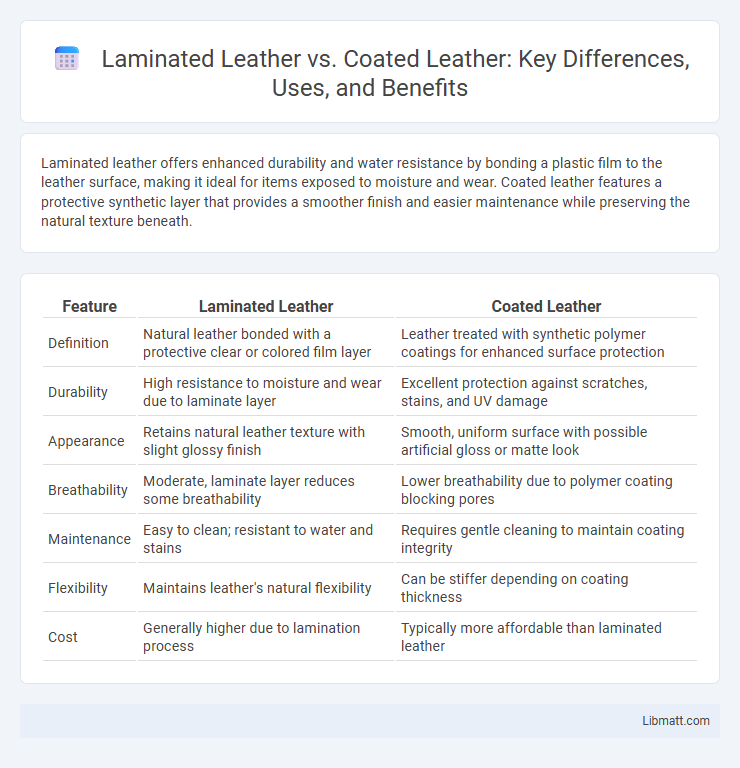Laminated leather offers enhanced durability and water resistance by bonding a plastic film to the leather surface, making it ideal for items exposed to moisture and wear. Coated leather features a protective synthetic layer that provides a smoother finish and easier maintenance while preserving the natural texture beneath.
Table of Comparison
| Feature | Laminated Leather | Coated Leather |
|---|---|---|
| Definition | Natural leather bonded with a protective clear or colored film layer | Leather treated with synthetic polymer coatings for enhanced surface protection |
| Durability | High resistance to moisture and wear due to laminate layer | Excellent protection against scratches, stains, and UV damage |
| Appearance | Retains natural leather texture with slight glossy finish | Smooth, uniform surface with possible artificial gloss or matte look |
| Breathability | Moderate, laminate layer reduces some breathability | Lower breathability due to polymer coating blocking pores |
| Maintenance | Easy to clean; resistant to water and stains | Requires gentle cleaning to maintain coating integrity |
| Flexibility | Maintains leather's natural flexibility | Can be stiffer depending on coating thickness |
| Cost | Generally higher due to lamination process | Typically more affordable than laminated leather |
Introduction to Laminated and Coated Leather
Laminated leather features a durable plastic film bonding that enhances water resistance and protects the surface from scratches, making it ideal for high-traffic use. Coated leather is treated with a polymer coating that offers a smooth finish and increased durability, ensuring your furniture or accessories maintain their appearance over time. Choosing between laminated and coated leather depends on your preference for texture, maintenance needs, and the level of protection required.
Understanding Laminated Leather: Key Features
Laminated leather features a protective plastic film bonded to the surface, enhancing durability and water resistance while maintaining the natural texture of genuine leather. This coating provides a glossy or matte finish that improves stain resistance and ease of cleaning without compromising flexibility. Commonly used in high-end upholstery and fashion accessories, laminated leather balances aesthetics and functionality by preserving original leather qualities alongside added protection.
What Is Coated Leather? Main Characteristics
Coated leather is genuine leather treated with a polymer finish, often polyurethane or acrylic, laminated onto the surface to enhance durability, water resistance, and stain protection. This finish provides a smooth, uniform appearance while maintaining the natural texture and flexibility of the leather beneath. It is commonly used in furniture, fashion accessories, and automotive interiors due to its enhanced longevity and ease of maintenance compared to untreated leather.
Manufacturing Processes: Laminated vs Coated Leather
Laminated leather is produced by bonding a thin layer of plastic or polyurethane film onto the surface of natural leather, enhancing durability and water resistance while maintaining the texture of genuine leather. Coated leather involves applying a polymer-based coating, such as polyurethane or acrylic, directly onto the leather surface, creating a smooth, uniform finish that can mimic various appearances and improve stain resistance. Both manufacturing processes aim to extend the lifespan and functionality of leather products, but laminated leather retains more of the natural leather feel compared to the synthetic texture of coated leather.
Durability Comparison: Laminated vs Coated Leather
Laminated leather offers superior durability due to its additional protective plastic layer, making it resistant to scratches, water, and wear compared to coated leather. Coated leather, while also providing a protective finish, tends to be less flexible and may crack or peel over time under frequent use. Laminated leather is often preferred for high-traffic items requiring long-lasting resilience and easy maintenance.
Aesthetic Differences and Design Options
Laminated leather offers a glossy, smooth finish that enhances color vibrancy and allows for intricate patterns or prints, making it ideal for bold, modern designs. Coated leather features a durable polymer layer providing a matte or slightly textured surface, lending itself to classic, understated aesthetics with a variety of color options. Design flexibility in laminated leather suits high-fashion applications, while coated leather excels in versatile, everyday use with enhanced weather resistance.
Performance in Everyday Use
Laminated leather offers superior durability and water resistance, making it ideal for everyday use in diverse weather conditions, while coated leather provides excellent stain resistance but may show wear more quickly with heavy friction. Both materials are designed to enhance longevity, but laminated leather's multiple protective layers help prevent cracking and peeling better than coated leather. For daily applications requiring robust performance and easier maintenance, laminated leather typically outperforms coated leather in preserving aesthetic appeal and structural integrity.
Maintenance and Care Requirements
Laminated leather requires gentle cleaning with a damp cloth and occasional conditioning to maintain its glossy finish and prevent cracking. Coated leather demands more frequent cleaning and the use of specialized products to preserve its protective surface and resist peeling. Both types benefit from avoiding prolonged exposure to direct sunlight and moisture to extend their durability.
Environmental Impact of Laminated and Coated Leather
Laminated leather often involves synthetic layers that can hinder biodegradability, leading to greater environmental concerns compared to traditional leather. Coated leather uses polyurethane or acrylic finishes that may release volatile organic compounds (VOCs) during production, impacting air quality and worker safety. Your choice between laminated and coated leather affects sustainability, with laminated leather typically posing a higher environmental footprint due to non-biodegradable additives.
Choosing the Right Leather: Laminated vs Coated
Laminated leather features a transparent protective film that enhances durability and water resistance while maintaining the natural grain, making it ideal for high-traffic items. Coated leather is treated with synthetic layers like polyurethane or acrylic, providing a smooth, uniform finish that resists stains but may reduce breathability and flexibility. Selecting between laminated and coated leather depends on the desired balance of texture preservation, durability, and aesthetic consistency for products such as upholstery, footwear, or accessories.
Laminated leather vs coated leather Infographic

 libmatt.com
libmatt.com